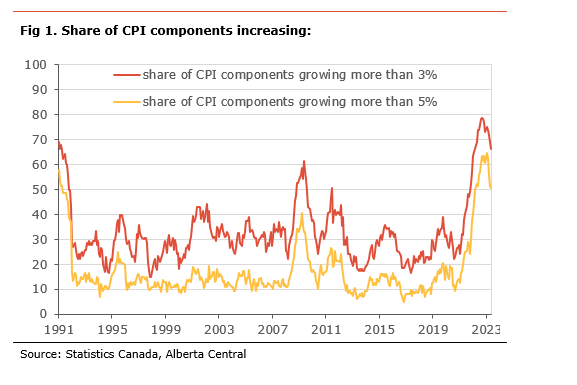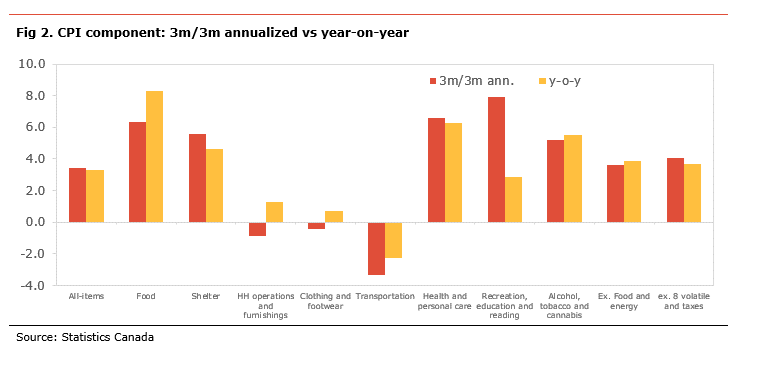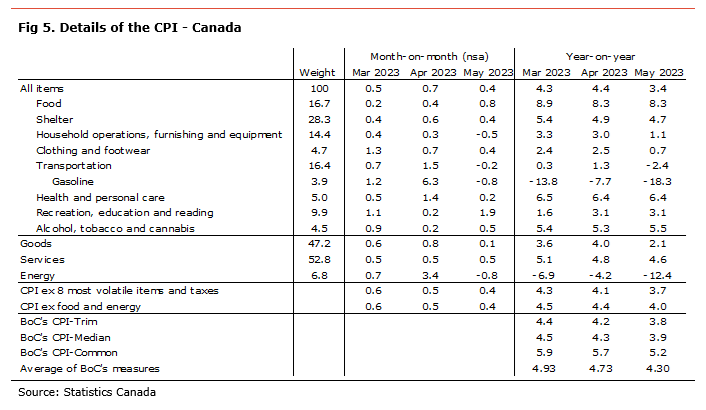Economic insight provided by Alberta Central Chief Economist Charles St-Arnaud.
Bottom line
Inflation decelerated to 3.4% in May, its lowest level since June 2021. The lower inflation rate is largely the result of lower gasoline prices while shelter costs, especially mortgage interest payments and rent, and food prices remain significant sources of inflation. There are continued signs of modest moderation in underlying inflationary pressures, with most measures of core inflation easing in May below 4%.
Inflationary pressures remain broad but are continuing to narrow slowly, with about half of the components of CPI rising at more than 5%, compared to 52% in April. Similarly, the share of components rising by more than 3% decreased slightly to 66% (see Fig 1.) A reduction in the percentage of components rising by more than 3% and 5% will be welcomed by the Bank of Canada as a sign that the moderation in inflation remains broad-based.
The recent trend in CPI’s monthly changes suggests that the momentum in inflationary pressures remains elevated, about 3.5%. Moreover, we can observe that many of the 3-month annualized changes in many CPI components are either on par with the year-on-year changes or slightly above, suggesting that the moderation in inflation maybe be stalling (see Fig. 2). The 3-month annualized changes in headline CPI is now at 3.4%, above the BoC’s target band. Similarly, the same measure for the BoC’s core measures is 3.7% on average. CPI excluding food and energy is at 4.2%, also above the BoC’s target range, while it is 4.0% for the BoC’s old measure of core (CPI ex the 8 most volatile components and indirect taxes).
Inflation continues to moderate but remains well above the BoC’s target of 2%, while inflation expectations remain elevated and inflationary pressures remain broad and likely sticky. The BoC is likely to consider the recent inflation dynamic, as measured by the 3-month annualized changes, slightly concerning and could support another increase in interest rates at the July meeting.
However, higher interest rates are having a significant impact on inflation. We estimate that inflation excluding food, energy and mortgage interest payments is about 2.3% and its 3m/3m annualized change is around 2.5%. This means that excluding the impact of the rate hikes, underlying inflation is in line with the BoC’s target and would not support further rate increases.
Ultimately, whether the BoC hikes in July may hinge on the strong momentum in the economy, with the strong labour market and consumer spending, and the desire of the BoC to restore its credibility as an inflation fighter and influence inflation expectations.
In Alberta, inflation dropped to 3.1%. The deceleration was mainly the result of a sharp decline in energy costs (+9.2% y-o-y), especially gasoline and natural gas prices. As such, energy costs are reducing inflation by 0.5 percentage points to inflation. Food prices accelerated and remained one of the main sources of inflation. Inflation excluding food and energy (a measure of core inflation) dropped to 3.3%, its lowest since February 2021.
The Consumer Price Index (CPI) increased by 0.4% m-o-m non-seasonally-adjusted in May and the inflation rate increased slightly to 3.4%, its slowest pace since June 2021. Prices rose on the month in six of the eight major CPI components, led by recreation, education and reading (+1.9% m-o-m) due to a 7.2% m-o-m jump in travel services costs. Food prices rose 0.8% m-o-m in May, while shelter costs increased 0.4% m-o-m, mainly as a result of a continued increase in mortgage interest cost (+1.8% m-o-m). Household operations, furnishing and equipment cost declined 0.5% m-o-m, led by lower cellphone costs. Transportation costs eased by 0.2% m-o-m, thanks a decrease in gasoline prices (-0.8% m-o-m).
Four of the eight major CPI components decelerated in May on a year-on-year basis. Food prices were the main source of inflation increasing 8.3% y-o-y, contributing 1.4 percentage points (pp) to inflation. Prices at grocery stores, especially for bakery products, and at table-service restaurants were the main source of food inflation. Shelter costs decelerated to 4.7% and remain one of the main sources of inflation, contributing 1.3 percentage points (pp), with about 1.1pp attributable to higher mortgage interest costs and 0.4pp due to higher rent. Transportation costs declined 2.4% y-o-y, reducing inflation by 0.4pp to inflation, with gasoline prices being the main drag on inflation by declining 18.3% y-o-y. Household operation costs grew at a slower pace of 1.1% y-o-y, contributing 0.2pp to inflation, with the deceleration attributable to a lower mobile phone services and childcare costs.
In May, goods prices inflation decelerated to 2.1% from 4.0%, while services inflation moderated to 4.6% from 4.8%. Energy prices dropped 12.4% y-o-y compared to the same month last year. Excluding food and energy, prices increased 0.4% on the month and rose by 4.0% compared to the same month last year, its lowest level since February 2022. The Bank of Canada’s old measure of core inflation, CPI excluding the 8 most volatile components and indirect taxes, moderated to 3.7%.
Looking at the BoC’s core measures of inflation, all three indicators decelerated in May. CPI-Median eased to 3.9% from 4.3%, CPI-Trim to 3.8% from 4.2%, and CPI-Common to 5.2% from 5.7%.
In Alberta, inflation moderated to 3.1% in May from 4.3%, its lowest level since June 2021. The main source of deceleration in inflation was from transportations cost, declining 1.1% y-o-y and reducing inflation by 0.6pp mainly as a result of lower gasoline prices (-13.9% y-o-y). Shelter costs decelerated in May, increasing by 5.1% y-o-y, compared to 5.6% y-o-y the prior month, contributing 1.3pp to inflation. This easing in shelter costs was due to a decline in natural gas prices (-7.4% m-o-m and -25.7% y-o-y) in May, reducing inflation by 0.3pp to inflation. Food prices accelerated to 8.3% y-o-y and the main source of inflation in the province, contributing 1.4pp to inflation.
Goods price inflation decelerated to 2.5% from 4.0%, while services prices eased to 3.7% from 4.5%. Inflation excluding food and energy dropped to 3.3%, its lowest since February 2022, while energy costs declined 9.2% y-o-y due to lower gasoline amd natural gas prices compared to last year.





Independent Opinion
The views and opinions expressed in this publication are solely and independently those of the author and do not necessarily reflect the views and opinions of any organization or person in any way affiliated with the author including, without limitation, any current or past employers of the author. While reasonable effort was taken to ensure the information and analysis in this publication is accurate, it has been prepared solely for general informational purposes. There are no warranties or representations being provided with respect to the accuracy and completeness of the content in this publication. Nothing in this publication should be construed as providing professional advice on the matters discussed. The author does not assume any liability arising from any form of reliance on this publication.